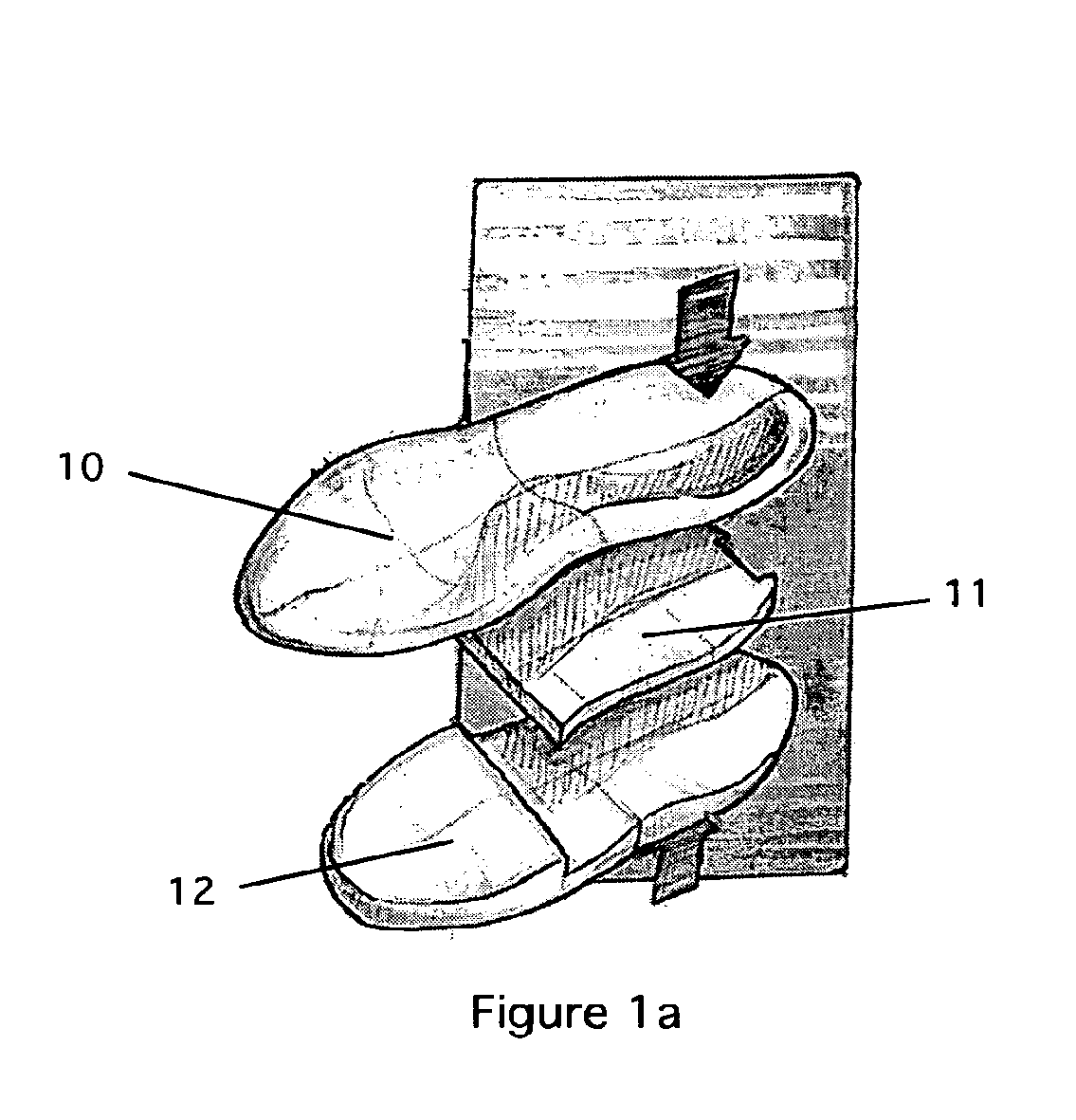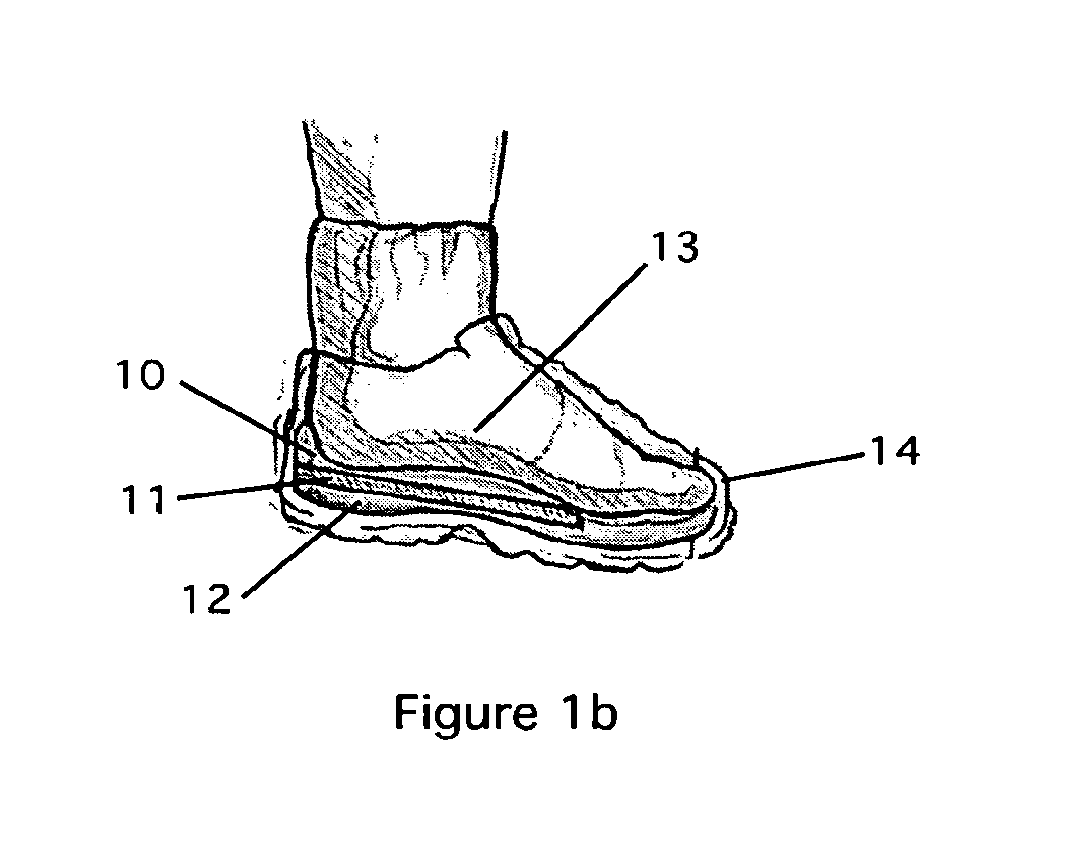Method and apparatus for improving human balance and gait and preventing foot injury
a technology of applied in the field of improving human balance and gait and preventing foot injury, can solve the problems of significant health problems in humans, lack of adequate mechanical sensory feedback, etc., and achieve the effect of improving the time response of the actuator
- Summary
- Abstract
- Description
- Claims
- Application Information
AI Technical Summary
Benefits of technology
Problems solved by technology
Method used
Image
Examples
first embodiment
[0083]With reference now the drawings, FIGS. 1a-1c illustrate a wearable system of the present invention in the form of a shoe insole insert. FIG. 1a depicts an exploded view of the insole insert device that is constructed of several layers. The top layer 10 of the insole is a conformable flexible layer which provides a comfortable interface between the foot and actuator components. This top layer 10 has typical foot contours and variations in thickness found on traditional insoles. It typically is made of foam, cloth, or gels. The intermediate layer 11 is an enclosure containing a rechargeable battery source and a control pod with signal generation circuitry, which are not shown for the purpose of clarity and simplification of the drawing. Details of the battery, control pod, and signal generation circuitry will become more apparent with the teachings of this and other embodiments of the present invention.
[0084]A bottom layer 12 shown in FIG. 1a is comprised of a material that can ...
second embodiment
[0092]FIGS. 2a and 2b depict the present invention. FIG. 2a illustrates an insole device including a disposable flexible pad 21 packaged in a disposable pouch 20. The device comprises of an insole pad 21 that is constructed of a thin conformable flexible layer containing thereon several electrode sites 23. A plurality of stimulation electrodes is incorporated in the electrode sites 23 on the top side of the pad facing the bottom of the foot. Stimulation electrodes may include, for example, disposable electrodes, re-useable electrodes to be used with conductive gel, or a new novel electrode design known as a stick-slip electrode system, which will be described in greater detail below.
[0093]These plurality of stimulation electrodes are coupled to a controller housed in a housing 22. Housing 22 also includes a power source, a signal generator, and a controller controlling the signal generator. The controller may also include user interface controls. This controller produces a nondeterm...
third embodiment
[0096]FIGS. 3a and 3b depict the present invention. FIG. 3a illustrates a stimulating device that comprises an ankle cuff 30 connected via a connector assembly 32 to a stimulating layer 31. Stimulating layer 31 is a platform for carrying stimulation electrodes and / or active vibrational actuators for applying stimulation to the plantar surface of the foot 13. Ankle cuff 30 houses electronic components connected to the stimulation electrodes and / or active vibrational actuators providing electrical or mechanical stimulation, respectively. The ankle cuff is wrapped around the ankle and its position is maintained by a fastening device 33, such as a hook-and-eye, Velcro strips, or a clasp, for example, while in use.
[0097]FIG. 3b depicts an expanded view of the ankle cuff of FIG. 3a. The material of the cuff is preferably soft and conformable and contains pockets 34 for batteries and controlling electronics circuitry. The ankle cuff 30 may also include stimulation electrodes or vibrational...
PUM
 Login to View More
Login to View More Abstract
Description
Claims
Application Information
 Login to View More
Login to View More - R&D
- Intellectual Property
- Life Sciences
- Materials
- Tech Scout
- Unparalleled Data Quality
- Higher Quality Content
- 60% Fewer Hallucinations
Browse by: Latest US Patents, China's latest patents, Technical Efficacy Thesaurus, Application Domain, Technology Topic, Popular Technical Reports.
© 2025 PatSnap. All rights reserved.Legal|Privacy policy|Modern Slavery Act Transparency Statement|Sitemap|About US| Contact US: help@patsnap.com



